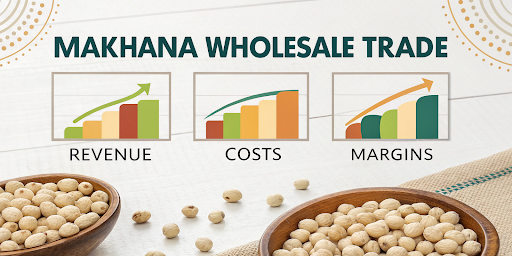Profit Margin in Makhana Wholesale Trade
- Written By:Vikrantsingh
- July 19, 2025

The Makhana industry in India, especially in states like Bihar, is rapidly evolving into a profitable business venture. With rising health awareness and the global popularity of fox nuts (makhana), there is growing interest in makhana trade — particularly at the wholesale level. Understanding the profit margin in makhana wholesale trade is crucial for wholesalers, entrepreneurs, and investors aiming to build a sustainable, high-profit business model.
Makhana Market & Demand Trends
Factors | Details |
Product | Makhana (Fox Nut) |
Hotspot Region | Bihar (especially Madhubani, Darbhanga, Purnia) |
Primary Buyers | Retailers, snack brands, health food chains, exporters |
Growth Drivers | Health benefits, low-fat snacking trend, Ayurvedic applications |
₹450 – ₹750 per kg (based on grade, size, and quality) |
Key Components of Profit in Makhana Wholesale Trade
1. Understanding the Value Chain
The makhana value chain spans across multiple stages:
- Cultivation
- Collection
- Processing (Popping, Cleaning, Grading)
- Distribution & Retail
Each stage adds value and affects the final selling price, impacting gross and net profit margins.
2. Cost Structures
Cost Elements | Description |
Raw Makhana Seeds | Purchase from cultivators or collection centers |
Processing & Grading | Labor, fuel, water, machine maintenance |
Packaging | Materials like air-tight pouches, jars |
Transportation | Local & distant distribution costs |
Marketing Costs | B2B platforms, local trade fairs, wholesale networks |
Tip: Keep processing and transport costs low by working with local suppliers and efficient supply chains.
Profitability Analysis
Gross Profit Margin
- Calculated before deducting operational costs
- Typical gross profit margin: 20%–35%
Net Profit Margin
- After deducting marketing, distribution, and working capital costs
- Average net margin: 12%–22% in an efficient makhana business model
Example Calculation:
If buying price is ₹500/kg and selling price is ₹650/kg:
- Gross Profit = ₹150/kg
- After accounting for ₹60/kg cost of processing, packaging, and logistics:
- Net Profit = ₹90/kg → 18% net margin
Factors Affecting Profit Margins
- Market Demand: Seasonal spikes during festivals increase profitability
- Size Grading of Makhana: Larger, fluffier makhana fetches premium pricing
- Market Power: Big traders and processors have better negotiation ability
- Demand and Supply: Scarcity increases makhana wholesale price in Bihar
- Retail Prices: High retail price gives more scope for markup at the wholesale level
- Business Model: B2B-focused distribution offers higher volumes, B2C offers higher margins
Marketplace Insight: Makhana Wholesale Price in Bihar
- Loose Makhana (unbranded): ₹450 – ₹550/kg
- Medium-sized Grade A: ₹600 – ₹700/kg
- Large Grade A (Roasted Makhana): ₹700 – ₹750/kg
- Flavored or Seasoned Makhana: ₹750 – ₹850/kg (bulk snack brands)
Pro Tip: Sourcing good quality makhana directly from makhana cultivators ensures better margins and supply consistency.
Strategic Points for High Profitability
- Build relationships with reputed suppliers in Bihar
- Optimize your makhana marketing channels
- Use a market entry strategy with bulk purchase to reduce per-unit cost
- Focus on competitive pricing while ensuring product quality
- Align with health brands or makhana-based sweets/snack manufacturers
- Ensure cost-effective supply and value chain management
Micro-Economic Insights for Wholesalers
- Working Capital: Essential for stockpiling during peak production
- Net Sales to Margin Ratio: A good indicator of financial health
- Market Efficiency: Avoid non-value-adding market middlemen
- Sector Analysis: Study makhana sector trends, market growth, and consumer behavior
Common Selling Points for Wholesalers
- Bulk sales to snack brands
- Distribution to urban retailers
- Supplies to Ayurvedic brands
- Export-ready packaging
The makhana business is one of the most lucrative trades under agricultural commodities with a fast-growing global makhana market.
Conclusion
The profit margin in makhana wholesale trade depends on multiple dynamic factors including market demand, pricing, supply chain efficiency, and business model. With the right strategies, makhana wholesalers can achieve a net profit margin of up to 20%, making it a highly profitable business.
If you’re exploring a makhana business or looking to enter the makhana market in Bihar, focus on direct sourcing, cost control, and value-added marketing channels to boost your profitability.
